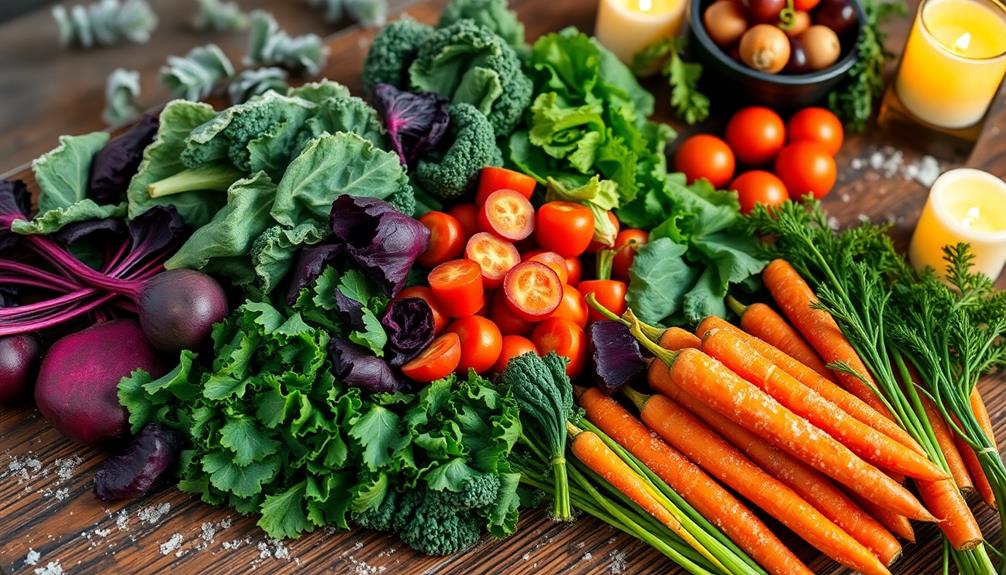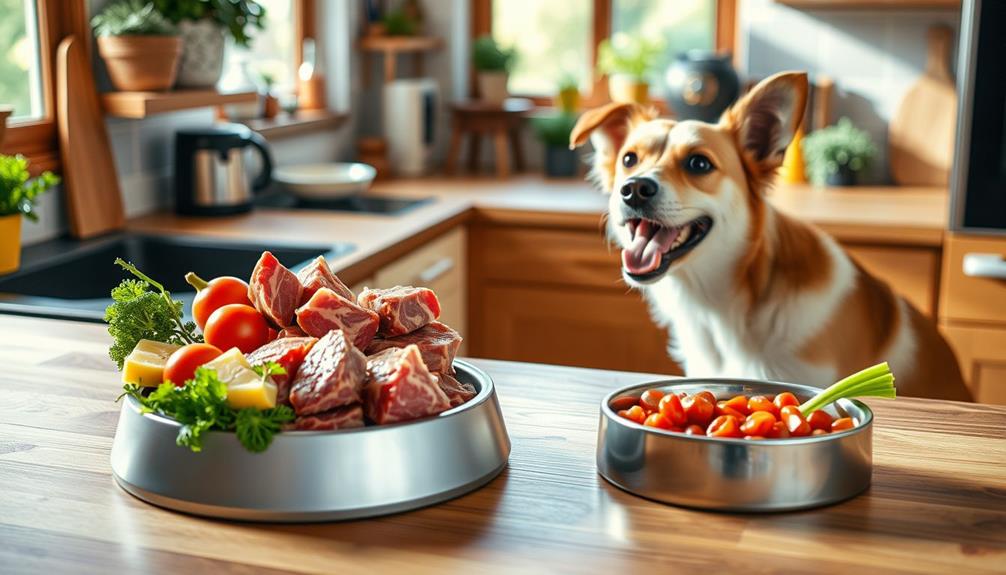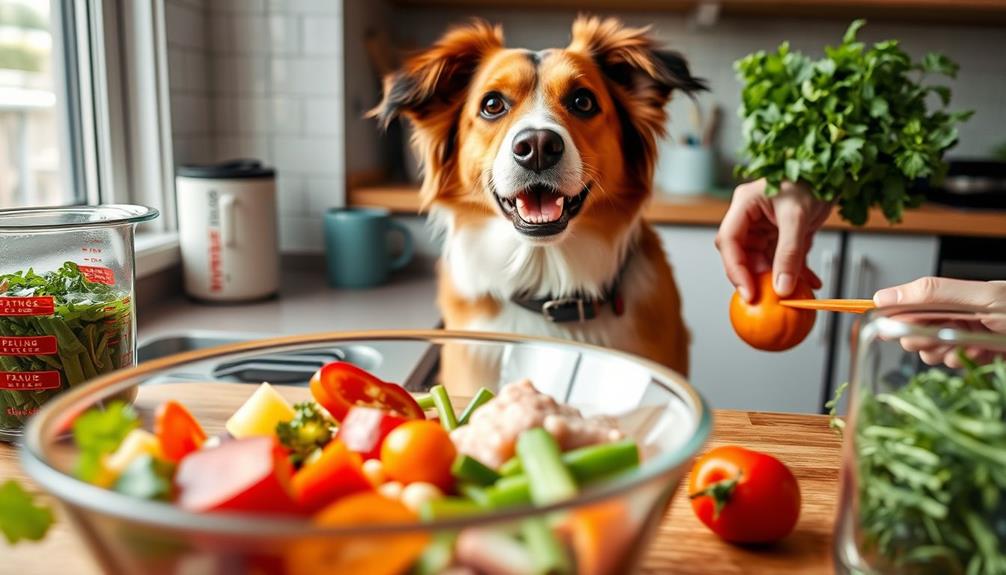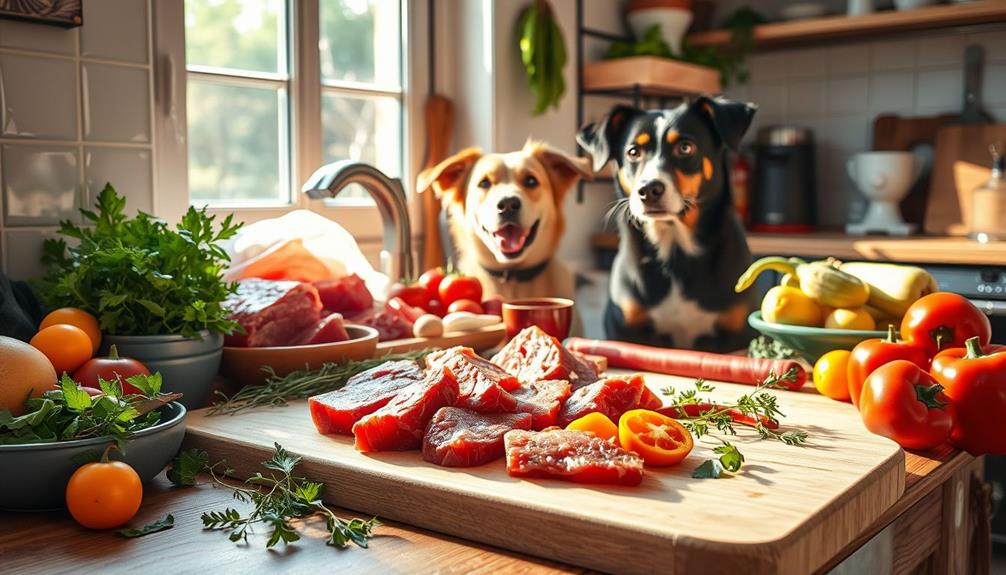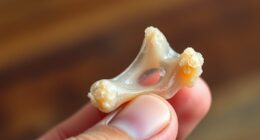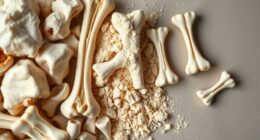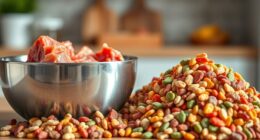If your dog isn't eating raw food, it could be due to picky eating habits, past diet experiences, or even health issues. They might need time to adjust, so give them 1 to 3 days. Try mixing raw food with familiar kibble, or warming it up to enhance its aroma. Be aware of distractions during meals; a calm environment can help reduce anxiety. If the refusal continues for more than a few days, or if you notice lethargy, consider talking to your vet. There's a lot more you can do to encourage your pup to embrace their new diet successfully.
Key Takeaways
- Dogs may require an adjustment period of 1 to 3 days when transitioning to raw food, so patience is essential.
- Mixing raw food with familiar kibble can help entice picky eaters and ease the transition.
- A calm feeding environment and consistent meal times can reduce anxiety and improve appetite during mealtime.
- Experimenting with different protein sources and enhancing flavor with warm water or broth can increase interest in raw food.
- Sudden changes in appetite may indicate health issues; consult a veterinarian if food refusal persists over 3-5 days.
Understanding Dog Behavior
When it comes to understanding dog behavior, many owners find themselves puzzled by their pets' eating habits. If your dog is a picky eater, it might be due to several factors. One major influence is their previous diet. If they've grown accustomed to kibble, making a change to new food can create an adjustment period where they refuse to eat. This can last from 1 to 3 days, especially if they're not comfortable with the new texture or taste.
Additionally, understanding that emotional factors, similar to those seen in caregiver support for seniors, can impact behavior is fundamental.
Environmental factors also play a significant role in your dog's appetite. Mealtime distractions, like noise or interruptions, can lead to anxiety, making your dog less willing to try new food. Establishing consistent feeding schedules helps reinforce comfort and safety, allowing your dog to anticipate when it's time to eat. This predictability can enhance their appetite and reduce fussiness.
Allowing your dog to explore new foods without pressure is essential. This approach helps them feel secure, reducing anxiety around mealtime.
Transitioning to Raw Food
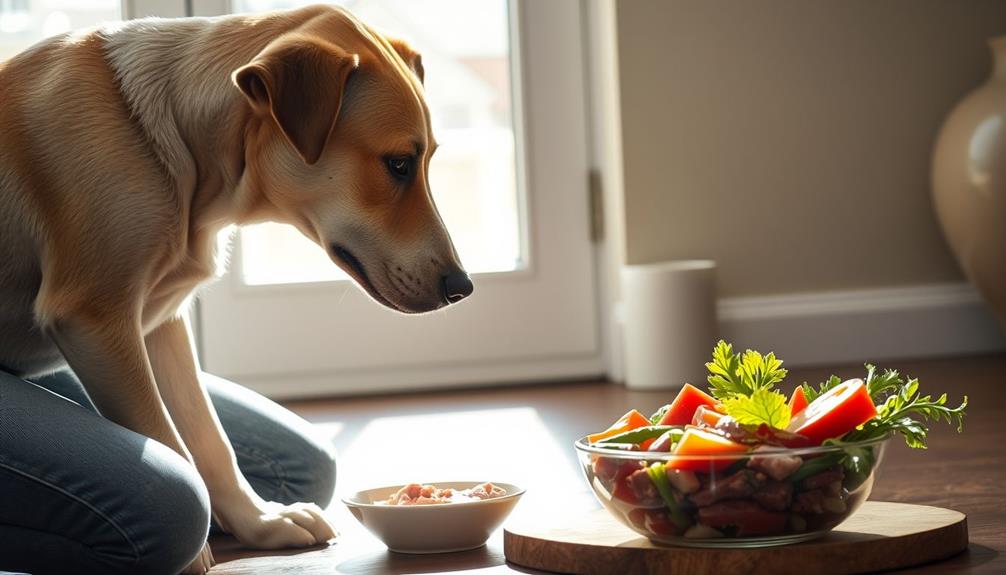
Shifting your dog from kibble to raw food can be a challenge, but with the right approach, it can lead to a healthier diet.
During the changeover to raw food, it's common for dogs to experience food refusal for a few days as they adjust to the new texture and smell. To ease this process, consider a gradual introduction—mixing raw food with their current kibble or adding enticing toppings can help make the change smoother.
Additionally, incorporating healthy dog snacks can encourage them to explore new flavors and textures.
Creating a calm feeding environment is essential. Distractions can lead to a dog refusing food, so eliminate noise and chaos during mealtime.
Offering a variety of proteins can also entice picky eaters; some dogs have specific tastes that might make them more receptive to certain meats.
Establishing consistent feeding schedules helps create predictability, which can enhance your dog's appetite and comfort with their new raw food diet.
Feeding Strategies for Success
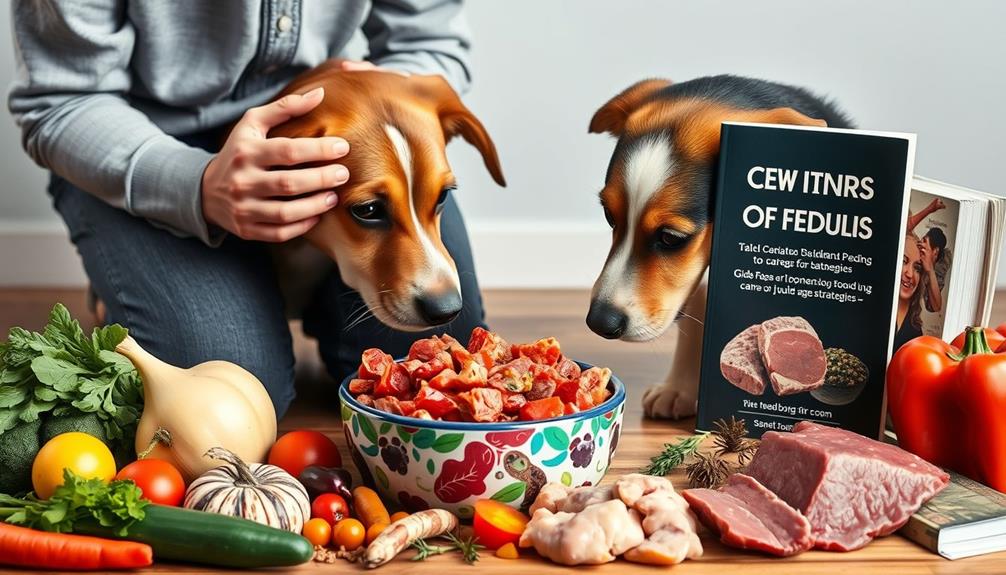
Finding the right feeding strategy can make all the difference when it comes to getting your dog to eat raw food. Start by gradually introducing raw dog food alongside familiar kibble; this can help entice picky eaters and ease the changeover process.
Establish a consistent feeding routine by setting specific meal times and avoiding leaving food out for extended periods. This promotes comfort and enhances your dog's appetite. Additionally, ensuring that the raw food is fresh and high-quality, similar to the importance of a hamster's diet proper diet essentials, can encourage your dog to eat.
To improve palatability, consider altering the texture of the raw food by adding warm water or low sodium broth. These adjustments can make meals more appealing and encourage your dog to try them.
Additionally, mixing different protein sources can help you identify your dog's preferred flavors, making it easier for them to accept raw food.
You can also enhance the meal experience by sprinkling a bit of parmesan cheese or adding low sodium broth to the mix. These feeding strategies not only improve palatability but can also make feeding your dog a more enjoyable experience.
Health Considerations to Address

Health considerations are essential when your dog refuses to eat raw food. If you notice a sudden loss of appetite or weight loss, it's vital to assess potential underlying health issues. Here are some important factors to monitor:
- Behavioral Changes: Lethargy or unusual behaviors may indicate a problem, and it's important to reflect on common types of cold medications that could affect your dog's overall health. Keep an eye out for any signs of distress.
- Existing Health Conditions: Dogs with pre-existing health conditions can be more sensitive to dietary changes. Monitor their response closely.
- Dental Issues: Oral pain can deter your dog from eating. Regular vet check-ups can help identify any dental problems that may affect their appetite.
- Recent Health Changes: Track any changes in health status or new medications, as these can impact your dog's appetite and willingness to try raw food.
If your dog continues to refuse their meals, don't hesitate to schedule a vet visit. It's better to err on the side of caution when it comes to your dog's health.
Monitoring these aspects will help guarantee your furry friend stays happy and healthy while adapting to a raw food diet.
Enhancing Meal Appeal
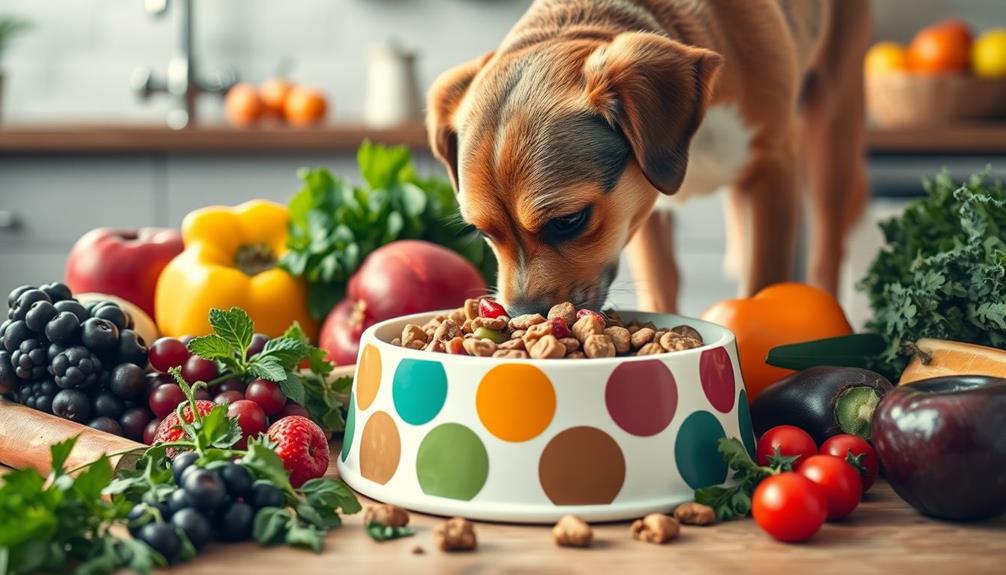
To make raw meals more enticing for your dog, consider enhancing the appeal of their food. Start by warming the raw food slightly or adding warm water or low sodium broth. This simple step can greatly improve the aroma and texture, making it more appealing.
Understanding the mechanics of flavor enhancement in foods can also help you create more palatable meals for your dog, similar to how various brewing methods affect caffeine levels in coffee different brewing methods. Experiment with different protein sources, like chicken, beef, or duck, to discover which flavors your dog prefers. This can help pique their interest in raw meals.
For picky eaters, mixing in highly palatable foods such as tripe or sardines can be a game-changer. These additions can entice them to accept raw food more readily. Serving the food at room temperature also helps; it can stimulate your dog's interest by enhancing its aroma and consistency.
Lastly, don't underestimate the power of healthy toppers. Adding freeze-dried fish or green-lipped mussel powder can boost nutritional value and meal appeal. By implementing these tips, you can create enticing meals that your dog is more likely to enjoy, making the change to raw food smoother and more enjoyable for both of you.
When to Consult a Veterinarian
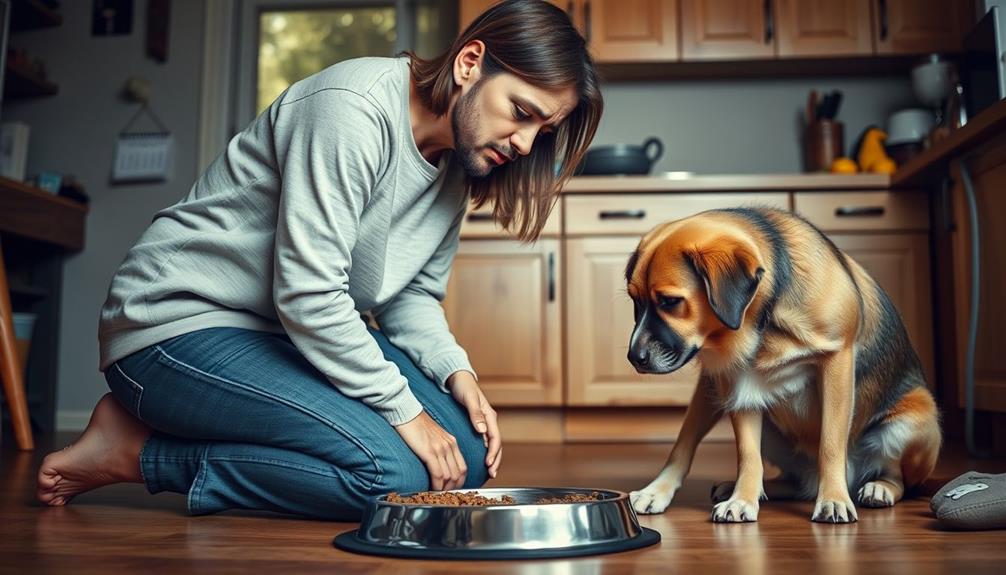
If your dog suddenly stops eating or shows signs of weight loss, it's essential to consult a veterinarian.
Regular check-ups can help catch any underlying health issues early, making a big difference in your dog's well-being.
Additionally, monitoring your dog's diet and ensuring it aligns with their nutritional needs can prevent potential problems; understanding common financial terms and jargon can also help you manage the costs associated with pet care.
Pay attention to any unusual symptoms, as they may signal the need for professional advice.
Signs of Health Issues
A sudden change in your dog's appetite can be a significant red flag, especially when it's paired with lethargy or unusual behaviors.
If your dog is refusing food, it's vital to pay attention to any accompanying signs that might indicate underlying health issues. For instance, emotional dysregulation in pets can sometimes manifest as changes in eating habits, much like in humans with Borderline Personality Disorder.
Here are four key signs to monitor:
- Persistent Loss of Appetite: If your dog refuses to eat for more than 24 hours, consult a veterinarian, especially if they're a puppy or have known health conditions.
- Lethargy: Noticeable fatigue or lack of energy can signal a serious issue that needs evaluation.
- Additional Symptoms: Watch for drooling, vomiting, or diarrhea, as these can indicate health problems requiring immediate attention.
- Changes in Behavior: Any unusual behaviors, like hiding or aggression, can also be warning signs.
Regular veterinary check-ups are fundamental to rule out dental issues or other health concerns affecting your dog's willingness to eat.
If you notice your dog is refusing food along with any of these symptoms, don't hesitate to seek a consultation. Monitoring symptoms closely can help guarantee your furry friend stays healthy and happy.
Importance of Regular Check-ups
Regular veterinary check-ups play an essential role in keeping your dog healthy and happy, especially when you notice changes in their appetite. If your dog suddenly stops eating or exhibits unusual behaviors, it's important to consult your vet. These visits help identify underlying health issues contributing to food refusal, such as dental problems or gastrointestinal disorders.
Here's a quick reference to help you decide when to visit the vet:
| Signs to Watch For | Action Needed |
|---|---|
| Sudden loss of appetite | Schedule a vet visit |
| Lethargy or unusual behaviors | Schedule a vet visit |
| Food refusal lasting over 3-5 days | Schedule a vet visit for assessment |
Regular check-ups not only monitor your dog's health but also provide opportunities for vaccinations and preventative care that can enhance their overall well-being. If your dog's appetite changes, maintaining open communication with your veterinarian is essential for timely interventions, ensuring your furry friend stays happy and healthy. Remember, your vet's assessment is important for their health, especially if food refusal persists.
Frequently Asked Questions
What if My Raw Fed Dog Is Refusing to Eat?
If your raw-fed dog's refusing to eat, try adjusting the food's temperature or adding appealing toppings. Also, make certain their mealtime environment is calm and distraction-free to help encourage their appetite during this shift.
How Can I Get My Dog to Eat His Raw Food?
Imagine your dog's a royal food critic. To entice him, mix raw food with kibble, create a feeding routine, and add tasty toppers. Experiment with different proteins and serve meals fresh for his discerning palate.
Why Did I Stop Feeding Raw Dog Food?
You might've stopped feeding raw dog food due to concerns about nutrition, convenience, or your dog's preferences. Maybe you noticed changes in their behavior or health, prompting you to reconsider their diet choices and feeding routine.
Why Is My Dog Not Eating His Food but Acting Normal?
Your dog might be experiencing temporary pickiness or distraction during mealtime. Changes in routine or unfamiliar food can also affect appetite. Establish a consistent feeding schedule to encourage your dog to eat regularly and feel secure.
Conclusion
In the grand tapestry of dog ownership, a reluctant eater can feel like a knot in the thread. But don't lose heart—by understanding your pup's behavior and making thoughtful adjustments, you can weave a solution. Remember, every dog is unique, and a little patience can go a long way. If all else fails, consulting a veterinarian could be your guiding star. With time and care, you'll find the right path to a happy, healthy meal time.


